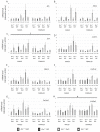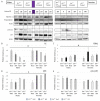Physiological Impact of a Synthetic Elastic Protein in Arterial Diseases Related to Alterations of Elastic Fibers: Effect on the Aorta of Elastin-Haploinsufficient Male and Female Mice
- PMID: 36362244
- PMCID: PMC9656458
- DOI: 10.3390/ijms232113464
Physiological Impact of a Synthetic Elastic Protein in Arterial Diseases Related to Alterations of Elastic Fibers: Effect on the Aorta of Elastin-Haploinsufficient Male and Female Mice
Abstract
Elastic fibers, made of elastin (90%) and fibrillin-rich microfibrils (10%), are the key extracellular components, which endow the arteries with elasticity. The alteration of elastic fibers leads to cardiovascular dysfunctions, as observed in elastin haploinsufficiency in mice (Eln+/-) or humans (supravalvular aortic stenosis or Williams-Beuren syndrome). In Eln+/+ and Eln+/- mice, we evaluated (arteriography, histology, qPCR, Western blots and cell cultures) the beneficial impact of treatment with a synthetic elastic protein (SEP), mimicking several domains of tropoelastin, the precursor of elastin, including hydrophobic elasticity-related domains and binding sites for elastin receptors. In the aorta or cultured aortic smooth muscle cells from these animals, SEP treatment induced a synthesis of elastin and fibrillin-1, a thickening of the aortic elastic lamellae, a decrease in wall stiffness and/or a strong trend toward a reduction in the elastic lamella disruptions in Eln+/- mice. SEP also modified collagen conformation and transcript expressions, enhanced the aorta constrictive response to phenylephrine in several animal groups, and, in female Eln+/- mice, it restored the normal vasodilatory response to acetylcholine. SEP should now be considered as a biomimetic molecule with an interesting potential for future treatments of elastin-deficient patients with altered arterial structure/function.
Keywords: aorta; elastic fiber synthesis/repair; elastin haploinsufficiency; mechanics; pharmacotherapy; reactivity; structure; synthetic elastic protein.
Conflict of interest statement
The authors declare no conflict of interest. The funders had no role in the design of the study; the collection, analyses, or interpretation of data; the writing of the manuscript, or in the decision to publish the results.
Figures











References
-
- Tucker W.D., Mahajan K. StatPearls. StatPearls Publishing; Treasure Island, FL, USA: 2019. Anatomy, blood vessels. - PubMed
-
- Chapter 7: The Cardiovascular System: Blood Vessels and Circulation—Anatomy & Physiology. [(accessed on 18 May 2022)]. Available online: https://qut.pressbooks.pub/anatomyandphysiology/chapter/chapter-20-the-c...
MeSH terms
Substances
Grants and funding
LinkOut - more resources
Full Text Sources
Medical

